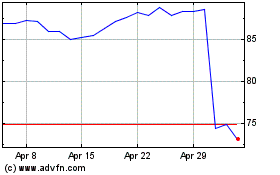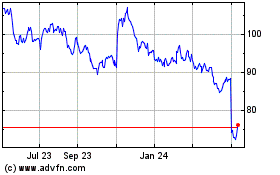By Corinne Ramey and Bob Tita
When reality-TV star Kim Kardashian West recently told her 115
million Instagram followers that her household stopped using
plastic straws, the head of an environmental nonprofit responded in
disbelief.
"I thought, 'Did we culture-hack this?' " said Dune Ives,
executive director of Lonely Whale, whose #StopSucking social-media
campaign advocates banning single-use plastic straws. "Did we
change the conversation around straws?"
This is the summer of the plastic-straw ban. Bans on straws have
swept through U.S. cities, businesses, restaurants and even sports
venues at a surprising speed. In recent months, officials in cities
including New York, San Francisco, Miami Beach, Fla., Santa
Barbara, Calif., and Portland, Ore., have either proposed or passed
bans on single-use plastic straws. Last month, Seattle became the
first major U.S. city to put a ban into effect.
Starbucks Corp., Hyatt Hotels Corp., Disney Co. and the Barclays
Center in Brooklyn, among others, said they would phase out
single-use plastic straws last month.
The story of how plastic straws went from ubiquitous to utensil
non grata is one of psychology, a well-timed turtle and the power
of social media. There has also been minimal industry pushback.
Susan Clayton, a professor of psychology and environmental
studies at the College of Wooster in Ohio, compared the movement to
the Ice Bucket Challenge, a 2014 social-media sensation in which
people posted videos of cold water being dumped on their heads and
donated to charity.
Activities like avoiding straws can lead to something
psychologists call moral licensing, Dr. Clayton said, in which some
people feel good about themselves for changing certain behaviors,
so don't feel the need to take further action.
"Do you do this little thing and say, 'Now I've done my part, so
I can drive to Starbucks instead of walking'?" she said. "Or do you
think, 'This saving the environment stuff isn't so hard after
all'?"
While calls for straw bans have accelerated in recent months,
advocates consider the movement's major boosters a social-media
campaign and a 2015 YouTube video of a bloodied straw being pulled
out of a sea turtle's nostril. The video has 32 million views.
The video "opened up a broader question: What are we doing with
single-use plastics?" said John Calvelli, director of the Wildlife
Conservation Society's Give a Sip campaign, which seeks to educate
New Yorkers about the impact of plastic pollution.
Some also credit the influence of an oft-cited statistic that
Americans use 500 million straws each day. The figure, which has
been cited by the National Park Service and others, including The
Wall Street Journal, comes from the 2011 research of a then
9-year-old Vermont boy and his mother.
Straws aren't the only single-use item to have been the subject
of environmentalists' ire. But campaigns to bring recyclable bags
to the grocery store or tote around reusable mugs haven't caught on
with the same verve.
"The kind of sacrifice that someone has to make to not get a
plastic bag is a bigger sacrifice than not having a straw," said
Melissa Checker, an environmental-psychology professor at the CUNY
Graduate Center in New York City.
Adding to the movement's success is its lack of organized
opposition. Some advocates for disabled people who need drinking
straws have spoken out against the bans, leading to exceptions to
some cities' proposed rules. Others who have opposed bans include
owners of bubble tea shops, who say the drinks' tapioca balls
require wide straws.
Some consumers note the convenience of plastic straws; they
allow for slurping an iced coffee while driving or walking, without
major spills. But such mundane complaints haven't coalesced into a
coalition.
To the extent that a straw-ban backlash has cropped up, much of
it has come from people who oppose the craze that has surrounded
the bans. Some oppose government working its way into their
soft-drink cups. Others question whether the bans aren't just a
self-congratulatory, ecological fad with little environmental
impact.
"It's so trivial," said Larry Grossman, 53, from Short Hills,
N.J., as he left a Starbucks in Manhattan.
"I've got a plastic lid," he said, pointing to his coffee cup.
"If they get rid of the lid next, I'd have to find another way not
to spill my coffee."
(END) Dow Jones Newswires
August 07, 2018 05:44 ET (09:44 GMT)
Copyright (c) 2018 Dow Jones & Company, Inc.
Starbucks (NASDAQ:SBUX)
Historical Stock Chart
From Aug 2024 to Sep 2024

Starbucks (NASDAQ:SBUX)
Historical Stock Chart
From Sep 2023 to Sep 2024
